On Kalai Arasi (1963; Queen of Arts): an experimental and space fiction movie
by Sachi Sri Kantha, March 18, 2023
Fellow MGR biographer R. Kannan’s observations, on Part 69, received on Jan 13th , was as follows:
“Read part 69. My humble thanks for mentioning my reaching and befriending you among the notable events. These sentiments, as you would imagine, are mutual. You have made deft use of You-tube interviews in addition to books; this part is no exception.
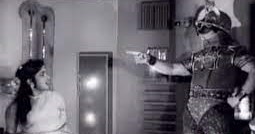
Villain Nambiar threatening heroine Bhanumathi, inside the flying saucer
The heights MGR touched both in Indian films and in public life remain unparalleled. Amitabh (Bachchan), a celluloid god, was a reluctant parliamentarian and beat a hasty retreat after one term. N.T. Rama Rao faced ignominy and revolt in his life term. He died a broken man. MGR faced electoral defeat on two occasions: one in the 1980 parliamentary polls and the second in 1986 in the local body elections. By 1986, MGR was almost physically only a shadow of his past self.”
My response to Kannan’s thoughts, sent on Jan 14th was,
“Pleased to hear your thoughts on Part 69. I very much appreciate it. Yes, I do agree that I was able to collect quite a number of recorded You tube interviews about MGR. Compared to the printed versions in the books (that of Sridhar, Aroordas, Kannadasan, Vaali, Nagesh, K.P. Ramakrishnan and Ravindar), these interviews have a delicate impression, because we are used to seeing their faces in the big screen, and it was as if, they are talking to us directly. In fact, on the You tube interviews, I had missed quite a few, such as actress Rajasree’s appreciation to MGR, directors P. Neelakantan and A. Jaganathan. It was my fault. Because, I was under the wrong impression that these are always available with a click. But, somehow, it doesn’t work.”
Error correction
Before I begin this chapter, I will correct an error, which had crept in the previous Chapter 69. This relates to the year of birth (YOB) of actor Major Sundararajan. I was informed on this, by a reader. I had erroneously noted that his YOB is 1925. This info was picked up from an earlier version of the Wikipedia entry. By cross checking that he was 68 [The Hindu, Mar 28, 2003], when he died in 2003, Sundararajan’s YOB is 1935, and not 1925.
Otto Friedrich’s view on Art and Politics
American journalist Otto Friedrich (1929-1995) contributed an essay to the Time magazine in 1987, in which he had compared the long term influence of art and politics. To quote,
“As time passes, all politicians (and generals) come to seem less important; what lasts is art. ‘Literature’, said Ezra Pound, ‘is news that stays news’. Many Americans can remember that Calvin Coolidge was the inconsequential President when Scott Fitzgerald published The Great Gatsby, but as we look back, the political powers keep fading. What does anyone know about the petty princelings who ruled Germany in the time Bach except that they were not very kind to Bach? What does anyone know about the Pope who built the Sistine Chapel except that he hired Michelangelo to paint the ceiling?”
I was strongly impressed by this observation of Otto Friedrich, and looked for an example of the long term influence of art against politics theme among the examples known for Tamils. It is this.
Kalyanasundaram’s lyric vs. Kamaraj’s Plan in 1963
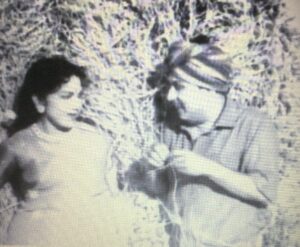
MGR and Bhanumathi – a screen grab in a village scene on Earth
Among the 133 Tamil movies MGR had starred, a couple of black and white movies like Koondu Kili (1954; The Caged Parrot) and Kalai Arasi (1963; The Queen of Arts), though not financially successful in their first release, had gained appreciation and recognition subsequently for different reasons. While Koondu Kili gained prestige because it was the only movie in which MGR and Sivaji Ganesan (1928-2001) starred together, Kalai Arasi had received recognition in the past decade as the FIRST space fiction movie produced in India. In this chapter, I revisit the details of Kalai Arasi movie, which had failed to receive its due from Indian movie historians (and even from MGR himself) for its unusual plot.
The plot in brief is this: Two representatives of alien species (villain Nambiar and his side kick; the name of Nambiar’s character in the movie is Theenan! to be interpreted in Tamil as ‘Theeyavan’ – bad man!), are on the look out in the Earth planet, for an ‘artist of repute’ (Kalai Arasi = Queen of Arts), because the art form is in short supply in ‘their’ planet. They check the India land via a monitor in their flying saucer abode – first the Northern region where the inhabitants were enjoying a folk dance in Hindi, and subsequently focus on Tamil Nadu, where the heroine (P. Bhanumathi) is singing a song, while playing Veena simultaneously). They opt to kidnap this ‘artist’ to ‘their’ planet and execute it. How an educated agriculturist (MGR; his character’s name is Mohan) retrieves his kidnapped love interest (Bhanumathi) from the Space planet by making a trip in the flying saucer, brings her back to the Tamil Nadu, is the story. The Space planet has a kingdom, and it’s princess (Rajasree) is the secondary heroine, who dallies with ‘clown’ MGR in that planet. MGR also ‘sings’ a duet with princess, in the Space planet. In my view, the solo song MGR ‘sings’ [voice by Sirkazhi Govindarajan – see below] in the Space planet in the clown character appears to be the crowning sequence of this movie. It is the only song (among nine) in the movie which promotes the MGR’s policy of having one meaningful song for educational purposes. The lyric for this song was written by Pattukottai Kalyanasundaram (1930-1959), but he didn’t live to see the released movie. But some MGR fans attribute this ‘image defying clown role’ taken by MGR to the mediocre run of the movie, in it’s first release.
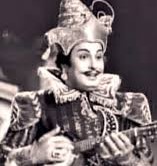
MGR singing, in a clown role, on the planet in Space
Kalai Arasi movie was released on April 19, 1963, when Jawaharlal Nehru was in the final full year of his prime minister period. He had suffered a serious setback to his policy and prestige, due to India’s defeat in the Indo-China border war between Oct 20 to Nov 21, 1962. The Congress Party leader K. Kamaraj was then the chief minister of the Madras. In August 1963, at a meeting of the Congress Working Committee, he presented a plan to revitalize Congress Party, associated with his name. This plan was voluntary resignation of all senior Congress leaders to resign from the positions they held then – such as the Chief Ministership of the state. Kamaraj himself resigned his position on Oct 2, 1963. This was politics. In contrast, a 20th century art form – a lyric of Pattukottai Kalyanasundaram, Athisayam paarthaen mannile [I’ve seen a miracle in the Earth], set in a lilting folksy tune by maestro K.V. Mahadevan (1918-2001) and sung with gusto by Sirkazhi Govindarajan (1933-1988) for MGR’s clown character to lip synch in the Kalai Arasi movie still shines for it’s description of the Indian landscape, within 3 minutes and 30 seconds. The You-tube link for this song is
https://www.youtube.com/watch?v=7_AeOc1fhH8
This year also marks the 90th birth anniversary of versatile singer Govindarajan with a temple bell-like voice tone, and his 35th death anniversary falls this month, on 24th.
Why is it that a Kalyanasundaram lyric, set to music and rendered by a gifted singer for MGR to act still sparkles in various platforms (radio, cassette, CD, DVD, iPad, Youtube etc.) after 60 years, whereas the Kamaraj plan failed to make ‘click’ and came to be long forgotten by Indian politicians and the public! It’s because, what Otto Friedrich had observed – an art form has the property to soothe human thoughts and mind, better than a political decision.
Not only this particular song, other 8 solo/duet songs which embellished this movie were also of remarkable quality for their composition and exposition. The details and Youtube links are presented below.
Neela vaana pandalin keezhe – singer T.M. Soundararajan, lyricist Alangudi Somu. Title credit song in the Earth, sung by MGR’s character.
https://www.youtube.com/watch?v=jgeSlPynGZM
Kalaiye un ezhil meni – singers Sirkazhi Govindarajan and Bhanumathi, lyricist Kannadasan.
https://www.youtube.com/watch?v=w214YO5pb34
Ninaikum pothu nenjum kannum – singer P. Bhanumathi, lyricist Pattukoddai Kalyanasundaram.
https://www.youtube.com/watch?v=MkbapXGW5qw
Nee irupathu inge un ninaiviruppathu enge – singers Sirkazhi Govindarajan and P. Susheela, lyricist N.M. Muthukoothan – a duet in the Space.
https://www.youtube.com/watch?v=uSJbckrI-zI
Singaaraa Vaa Vaa – singer P. Bhanumathi, lyricist N.M. Muthukoothan
https://www.youtube.com/watch?v=MCegSXQJ_sQ
Aasai vaikira idam theriyanum maranthuvidathe – singers P. Bhanumathi and Jikki, lyricist Pattukottai Kalyanasundaram.
https://www.youtube.com/watch?v=wN5JqUufOJo
Enrum illamal onrum sollamal inbam – singer P. Leela, lyricist Pattukottai Kalyanasundaram.
https://www.youtube.com/watch?v=cgHxD9S1r9o
Kettaalum kettadhu ippadi – singer A.G. Ratnamala, lyricist N.M. Muthukoothan
https://www.youtube.com/watch?v=18LFCPVLpbE
Even a sourpuss reviewer who wrote a distorted negative review for this movie in the Kalki weekly (see below), had commented positively about three (of the nine) songs.
Two Movie Reviews (one positive and one negative)
The anonymous reviewer to the Indian Express daily offered a positive review to the movie. It was as follows:
“The central character in the story is a young woman (P. Bhanumathi) who is kidnapped by a man from outer space, and is whisked off to a planet in a flying saucer. There she teaches music to the daughter of a Space King and propagates the cultural heritage of South India to the inhabitants in the planet. Meanwhile, the father of the girl continues his search for her and through his ward meets another insane girl, looking exactly like his own daughter.
Mohan (M.G. Ramachandran), the college mate of the zamindar’s daughter, takes upon himself to find the girl and after overpowering one of the spacemen, air dashes to the planet in the flying saucer. He finds her and works his way to come down to the Earth. How the young man overcomes all his obstacles in the planet and how the identity of the two girls is established, form the climax of the film, which is studded with a plethora of synthetic thrills, stunts and chases.
M.N. Nambiar, P.S. Veerappa, N.S. Narayana Pillai, Rajasree, Kumari Saraswathi, G. Shakuntala, S.R. Janaki, C.T. Rajakanthan, Kamala and Mohana are the other members of the cast. Directed by A. Kasilingam, the film has all the ingredients that make a successful box office production.
The film is exceptionally good in outdoor and trick photography, for which credit goes to the cinematographer J.G. Vijayam. Music by K.V. Mahadevan is good.”
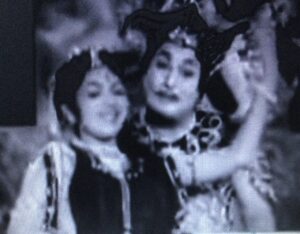
MGR (in a clown role) and Rajsree – screen grab on the Space planet
A sourpuss critic with a pseudonym Kanthan wrote a negative review in the Kalki weekly. An English translation of this review follows:
“Without thinking about the story, without thinking about capturing audience support, without thinking a bit about artistic focus, direction, ‘tempo’, Kalai Arasi had been produced by Sarodi brothers.
The movie has one hero, two villains – while one of them is in the Earth, other one is from the Space. Both villains are known to us – Veerappa and Nambiar. M.G. Ramachandran plays two roles. One is a youngster named Mohan. Other one is a clown in the Space world. Bhanumathi also has two roles. One is Vani – the Queen of Arts. Other one is Valli, a mentally defective woman. Beyond this, one need not think more about the story. Rather than the Vani character, the mentally defective Valli character appeals more. My opinion is ‘Kalai Arasi’ has appeared for Bhanumathi to lose the well earned compliments from her role in ‘Annai’ movie.
Why did M.G. Ramachandran come? What did he do? One must yearn to comprehend the purpose of his character? [He] loves, goes to prison, protects his sister, fly in the flying saucer to meet his lover. Takes on the clown role and jump-walks [in Space] and dies. Why did he agree to act in this movie? Adad – Ramachandra!
The song Bhanumathi sings in her own voice, Ninaikum pothu nenjum kannum sounds sweet. Another duet song, Kalaiye un ezhil meni Bhanumathi sings with Sirkazhi Govindarajan is also very good. T.M. Soundararajan’s uplifting song at the beginning Neela vaana pandalin keezhe is excellent too. This movie cannot be appreciated, cannot be enjoyed and one cannot laugh. Thus, I was able to satisfy myself that there are good songs to listen in the movie.
Kalai Arasi is advertised as a movie which portrays the scientific merits and miracles. But, when watching it, what comes out is the ignorance and gullibility of the producers. What is the link between the ‘kingly dresses’ of aliens and the current electronic devices fixed to the flying saucers, and what a trouble!
The first place for acting should go to the flying saucer. It elevates itself and land itself, with hardly an effort. There was a testing scene – the fight between MGR and Nambiar in the flying saucer. So long! Haa – just a pain!
Rajsree and Kumari Saraswathi had not only acted, but danced as well. By taking seven years to produce this ‘Kalai Arasi’, and by releasing, producers had avenged the Tamils. They had tested the patience, too much – thanks ‘Kalai Arasi’. Thanks to the producers and thanks to those who have acted in it. What sin Tamils had done to you? Why you have made them pay for it? This is an inexcusable crime.”
Vital details on the production of ‘Kalai Arasi’
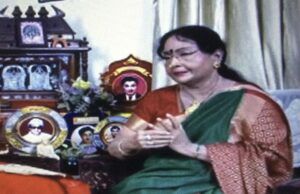
Rajasree – in a recent interview at her home, with MGR memorablia in the background
The original story was by T.E. Gnanamoorthy. It was scripted for film by MGR’s writing assistant Ravindar. What critic ‘Kanthan’ had observed on the production delay of this movie is true – partially. May not be 7 years – but it took over 4 years (from early1959 to early 1963). I could identify at least four reasons for this delay. These are,
- Creative conflict MGR had with actress heroine P. Bhanumathi, that arose during the shooting of his own production ‘Nadodi Mannan’ movie in 1958. In this movie, Bhanumathi’s character was abruptly ‘finished off’. There needed some ‘healing time’ between both MGR and Bhanumathi to come together. Considering their busy schedules, both could have easily abandoned this movie once and for all. But, as both might have realized that a science fiction movie in India was a first of its kind, both MGR and Bhanumathi never gave up coming together again.
- Stage accident in Sirkazhi in mid 1959, that fractured MGR’s leg, that needed months of healing and rehabilitation.
- Death of MGR’s second wife Sadananthavathi in Feb 1962.
- An undisclosed conflict MGR had with the producers Sarodi brothers and financiers of the movie.
After 60 years, the production difficulties this movie faced has been obscured by the deaths of the principals (MGR, Bhanumathi, director A. Kasilingam, script writer Ravindar) involved. Nevertheless, two actresses who had starred in this movie – Rajasree and Kumari Saraswathi (Sachu) are still alive. Nine songs were featured in the movie, four of which were written by Pattukottai Kalyanasundaram. He had died in October 1959, and the time lapse between his death and the eventual release date of April 1963 was 3 years and 6 months.
Another indicator for the delay, was a cryptic note in the memoir of script writer Ravindar. Both he and Kannadasan were the principal writers for MGR’s ‘Nadodi Mannan’, released on Aug 22, 1958. Then, Kannadasan’s elder bro A.L. Srinivasan produced the ‘Thirudathe (1961; Do not Steal) movie. “[MGR had] requested both Kannadasan and Ravindar to write the scripts jointly for the Thirudathe (1961) and before that Kalai Arasi (1963) movies. Kannadasan had pleaded that ‘I don’t know the nitty gritties of Moon land and Mars land. So, I write ‘Thirudathe’ and [you] write ‘Kalai Arasi’ and we had split the assignments.” Thirudathe movie was released on Mar 23, 1961, and became a box office hit. But, it took another two years for the Kalai Arasi movie to be released in 1963.
‘Kalai Arasi’ and ‘2001: A Space Odyssey’
Comparison between Kalai Arasi and 2001 A Space Odyssey
That Kalai Arasi pre-dated the release of Stanley Kubrik’s space fiction classic ‘2001: A Space Odyssey’ (1968) by five years, as well as the first of its kind moon landing of Neil Armstrong and Buzz Aldrin by six years deserves notice. As facts, first it deserves notice that India launched a 10 kg ‘toy rocket’ into outer space from the Thumba Equatorial Rocket Launching Station near Trivandrum, coincidentally in 1963. Secondly, it also took four years for Kubrik to complete his ‘2001: A Space Odyssey’ as well. Though the story plots differ between the two movies (as one would obviously expect between a Hollywood movie and an Indian movie), in a table presented nearby in a PDF format, I provide a comparison of parameters between ‘Kalai Arasi’ and ‘2001: A Space Odyssey’. Currently available Youtube digitized version of Kalai Arasi movie (https://www.youtube.com/watch?v=Q_p5D5Md97Y) that runs for 152 min is 14 min shorter than the original print.
Considering the technological demerits faced in the production of science fiction movies during late 1950s and early 1960s, such as using a heavy weight camera equipment that need to be moved around outdoors and lack of zoom lenses, a revolutionary concept of producing an experimental space fiction movie in India, by MGR and director Kasilingam with trick photography deserve belated recognition. Unfortunately, neither the editors of the Encyclopedia of Indian Cinema (1999) nor Tamil movie historians like Aranthai Narayanan and Theodore Baskaran had ignored including this movie in their commentaries. Ironically, the Encyclopedia of Indian Cinema, provides synopsis of a total of 22 MGR movies. But, ‘Kalai Arasi’ was excluded. In addition, even MGR himself had failed to mention any specific details about the ‘Kalai Arasi’ movie in his autobiography, though he had described his anguish of waiting for B. Sarojadevi to arrive for indoor shoots for the successful Thirudathe movie. Also, he had passingly mentioned about the character trait and work ethic of director A. Kasilingam, who was more an intimate friend of his elder brother M.G. Chakrapani. This Kasilingam had previously directed MGR in three movies, Abhimanyu (1948), Maruthanaatu Ilavarasi (1950) and Naam (1953).
Another notable feature in the casting of the ‘Kalai Arasi’ movie was the absence of ranking comedians (of either sexes) in the movie. Only C.T. Rajakantham (an old timer and a regular in MGR movies; also a reel and real life partner of MGR’s guru comedian Kali N. Rathinam) is included in the supporting cast, but she doesn’t perform any comedy routines.
Coda
Once he established himself firmly in the Tamil films as an established star since mid 1950s, it has been recorded the MGR made the final decision of naming his movie, after listening to the views of other personalities concerned with the movie production. The given title for this movie ‘Kalai Arasi’ is heroine-centered. My postulation is, this was indeed an appropriate title based on the movie plot. But, MGR was magnanimous in recognizing the talent and skills of his heroine (P. Bhanumathi) for her continued collaboration, despite the fall-out they experienced in the completion of ‘Nadodi Mannan’ (1958) movie.
I do accept that ‘Kalai Arasi’ is not in the same caliber of Stanley Kubrick’s ‘2001; A Space Odyssey’. Comparisons are devious, and ‘apples and oranges’ should never be compared. Nevertheless, as Kalai Arasi predated ‘2001: A Space Odyssey’ by almost five years, its specific achievement as first space fiction movie in a resource and technologically poor India deserve hindsight appreciation, in its 60th anniversary year. And the glory should be shared equally by the movie’s lead players – MGR, Bhanumathi and Nambiar. Is it wrong, if I infer that they were some kind of ‘visionaries’ in a sense, for attempting a new genre of movies in India?
Cited Sources
- Theodore Baskaran: The Eye of the Serpent – an introduction to Tamil Cinema, Tranquebar Press, New Delhi, 2013.
Otto Friedrich: What really mattered? Time, Oct 12, 1987, p. 45.
Kanthan: ‘Kalai Arasi’ movie review. Kalki, May 5, 1963.
MGR: Naan Yean Piranthen (Why I was Born), Part 2, Kannadhasan Pathippagam, Chennai, 2014, pp. 1248-1254 (in Tamil).
Our Film Critic: ‘Kalai Arasi’ movie review. Indian Express, Apr 26, 1963, p. 3.
Aranthai Narayan: Thamizh Cinemavin Kathai, 3rd ed., New Century Book House, Chennai, 2008.
Ashish Rajadhyaksha and Paul Willemen: Encyclopedia of Indian Cinema, new revised ed., Oxford University Press, New Delhi, 1999, pp. 24-25.
Ravindar: Pon Mana Chemmal MGR, Vijaya Publications, 2009, p. 63
*****
This is a lovely article throwing light on little known facts about the dynamics between MGR and Bhanumathi.
As usual, MGR is magnanimous by working with her again in the best interest of the movie.
The authority of Bhanumathi is recognized by Sivaji too in the rare interview below:
https://www.youtube.com/watch?v=-g63DoH7Wqc&ab_channel=RajivMehrotra